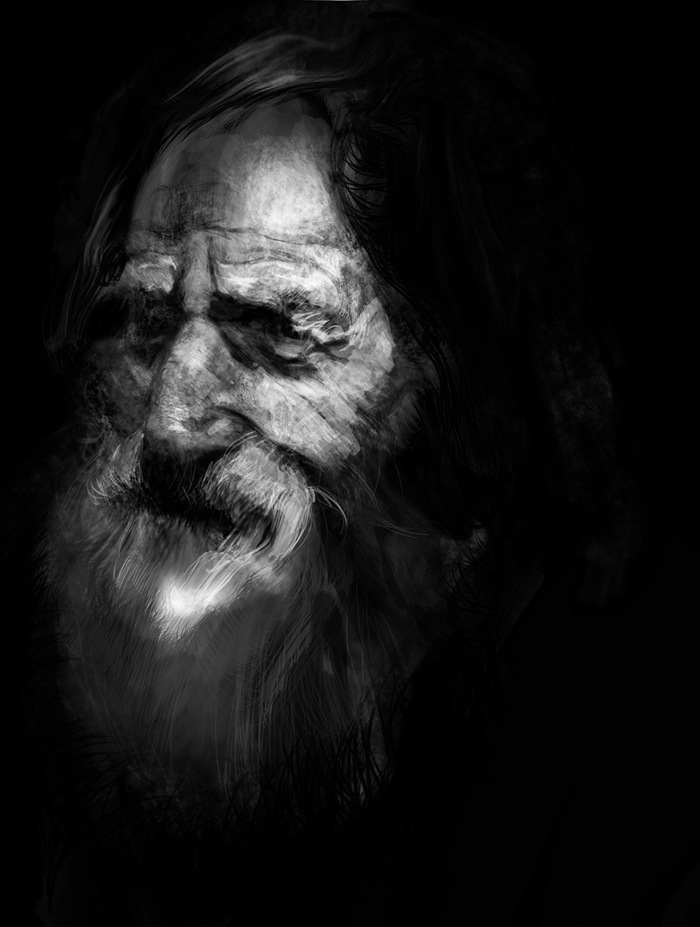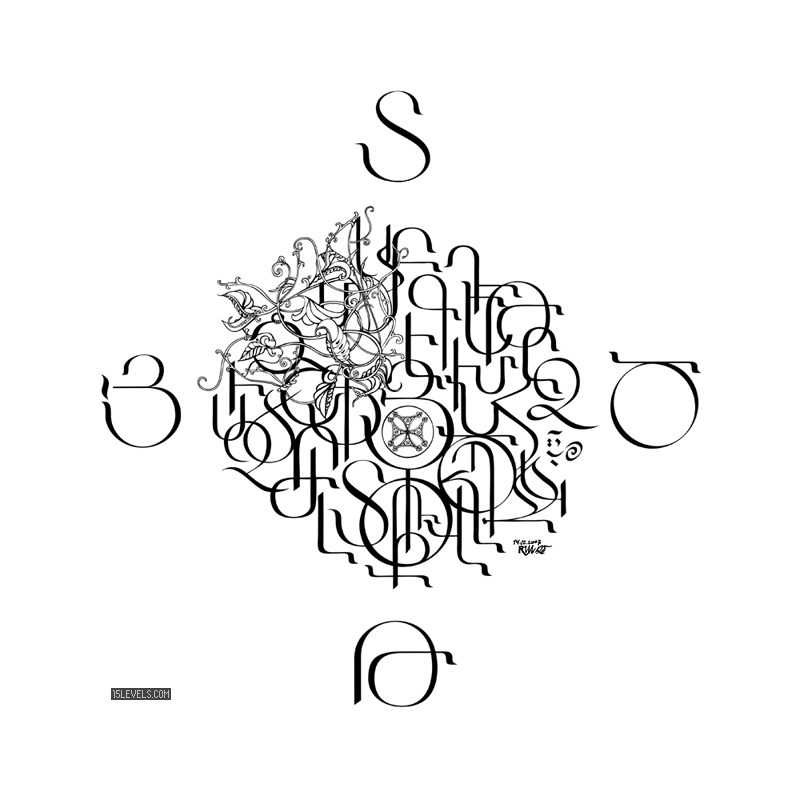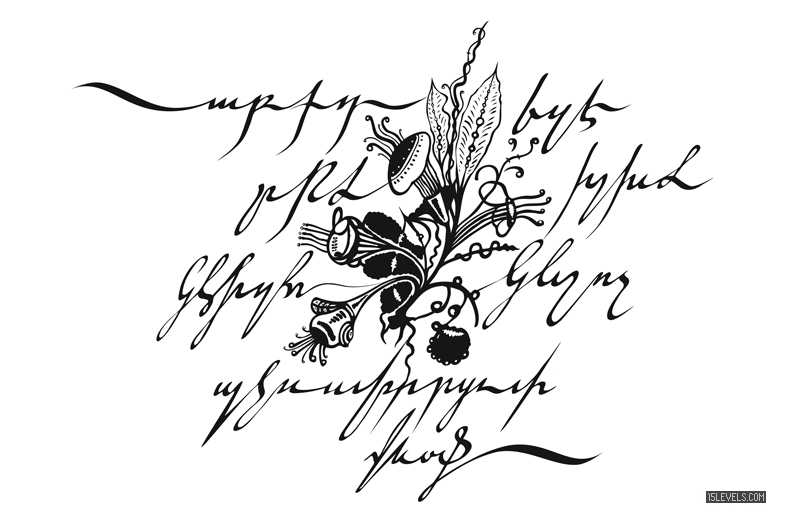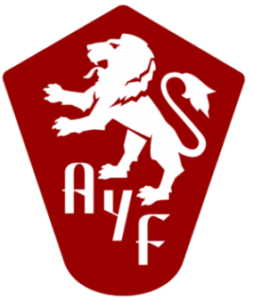State of the Arts – Rouben Malayan
Haytoug: Can you tell us a little about yourself? Some background on where you’re from and how you got involved in calligraphy in general.
Rouben Malayan: I was born in Yerevan in the spring of 71. Went for four years to Terlemezian college of art (painting), continued to the academy (graphics) and in May 93 left Armenia to Israel. 16 years in Tel Aviv, 2 years in Amsterdam, now I am trying my luck back home in Hayastan. Many questions, few answers, but its an ongoing process of reconnection and I was prepared for it before I made the leap forward. Its challenging but very interesting experience. Two years ago I had a request from the Editor of upcoming “The Encyclopedia of World Calligraphy” to contribute to the edition by drawing samples of Armenian script. It was a challenge since I have not practiced calligraphy extensively and my interest in the art of writing was part of a larger issue of typography in graphic design. But it was clear to me that calligraphy is where it all begins. I was fascinated with what I have found when I began to look for answers. Some of it can be found here http://15levels.com/art/armeniancalligraphy/
H: Is your foundation based on formal training or did you develop your talent in other avenues?
RB: I was lucky to be born to a family of an artist, so from the day one I was exposed to the world of art. My father taught drawing in the Academy for over 40 years and I had the privilege to learn from one of the best teachers of the old generation. Academic background in fine art is essential for anyone who seriously wants to develop and I caught few good years in the college and academy, before we began to loose our teachers, one by one. Today almost nothing is left of once glorious art education we had in Armenia. Its mediocre at best.
H: How would you describe your style?
RB: I am a realist. And I love form. Somehow I have little envy for people who have a rich perception of color, since I am a graphic artist; I see the world in shapes, contours, light and shade, but rarely color. My father was a great colorist, but you can’t be good at everything. But I think once I have the right conditions, I will go back to experimenting with color.
H: Can you tell us a little about 15 levels? When did it start, what kind of things do you do and what are some key projects that you’ve worked on?
RB: When I wanted an online portfolio, I looked for a suitable name for the domain, something abstract but with a meaning for myself. It was the years (1997) when electronic music was making it’s first steps and a German DJ Riz Mazlen was recording under the label of “Neotropic”. She released an album called “15levels of magnification” which I loved. So there was the name I was looking for. Basically it became the test field for my design ideas, changed its appearance for countless times, but today I am very satisfied with the way it looks. I was among the first generation of graphic designers who went digital when it became clear its the only way forward. For past decade I have been working for broadcast, art directing commercials, TV channel branding and promos in Israel and Netherlands. Now I am the creative director of a post production and 3D animation agency based in Erevan – “Triada Studio” ( www.triadastudio.com ). They have a lot of talent and a bright future, no doubt.
H: Can you tell us about some of the Armenian genocide awareness posters you have designed
RB: In Amsterdam (2000), I found myself living in a predominately Turkish neighborhood of the city. I realized how small and underprivileged was the Armenian community, which was almost entirely assimilated at some point. Turks have the advantage of numbers and politics are influenced by voters. Holland is a democratic country, has a good education system, people know and remember history. But they knew little about the Armenian genocide and the atrocities Turks committed against the Armenians. The idea was born to educate the general public using graphic posters which are accessible to everyone. We called on designers to participate in the project and with help of few Dutch and Armenian friends published five winning posters (one in Turkish). On the morning of April 24th we placed them wherever we could in the city. It was an amazing feeling to see our work draw attention. I want to believe the project contributed to the efforts to have Armenian genocide recognized by the Dutch parliament. The project can be found here: http://ArmenianGenocidePosters.org/
H: For many people, finding motivation to be creative and developing original concepts is not easy. Where do you find your inspiration?
RB: First and foremost, our own culture. So many beautiful works of art, thousands of years of history, without roots we have no future. These days it’s very easy to get absorbed in the mainstream flow of popular culture, which has very low standards when it comes to quality and originality. Everything is done and redone, copied without any discrimination. So to me, only art which passed the test of time has a real artistic value. In short, for me it stops with the Avant-garde.
H: What role do you think art and design plays in Armenian culture, especially for us today in the Diaspora? And in Armenia?
RB: I think we need a very different approach today. For Diaspora our language is “the last line of defense” so to speak. And I mean the Armenian which is not polluted by slang. Its so irritating to hear Armenians speak some sort of mutation. Our language is beautiful and rich, it needs to be treated as such. And written language is inseparable from spoken one. We have serious issues with contemporary typography in Armenian which is an essential element in visual communication. Now and then we see some problems being dealt with, thanks to the positive and constructive approach of people who haven’t given up on it. Sadly the new generation is absorbed by subculture which has very little to do with anything Armenian, or anything really valuable. There always will be the forces of destruction and as long as we keep creating quality work to counterbalance it – we are good. People should realize that our intellectual and cultural potential is all we have. From that (eventually) will come unity.
H: What are some recent and upcoming projects we can expect from you?
 RB: The book on the Art of Armenian Calligraphy, is what I want to keep working on, the idea is to collect into one beautiful volume the best and the most interesting material, most of which is inaccessible because its been long forgotten in the libraries scattered around the world. I’d love to go do research in BnF (The National Library of France) but I need a grant for it. Venice, Vienna and London have fantastic libraries as well. And its only a tip of the iceberg, so much more is yet to be re-discovered. I think the time is ripe to bring about a positive change in the education system and revive the studies of Calligraphy as a discipline in the school. Our children should learn to write a beautiful version of our letters, rather than the most primitive one. Its only changing the sample, imagine, how simple yet effective a change like that can be? There are school books which are still used in Persia, where Armenian Classical Education is taught. I have written an article on it which was published in Asbarez and Armenian Weekly. http://asbarez.com/90950/the-art-of-calligraphy-script-in-its-purest-forms/
RB: The book on the Art of Armenian Calligraphy, is what I want to keep working on, the idea is to collect into one beautiful volume the best and the most interesting material, most of which is inaccessible because its been long forgotten in the libraries scattered around the world. I’d love to go do research in BnF (The National Library of France) but I need a grant for it. Venice, Vienna and London have fantastic libraries as well. And its only a tip of the iceberg, so much more is yet to be re-discovered. I think the time is ripe to bring about a positive change in the education system and revive the studies of Calligraphy as a discipline in the school. Our children should learn to write a beautiful version of our letters, rather than the most primitive one. Its only changing the sample, imagine, how simple yet effective a change like that can be? There are school books which are still used in Persia, where Armenian Classical Education is taught. I have written an article on it which was published in Asbarez and Armenian Weekly. http://asbarez.com/90950/the-art-of-calligraphy-script-in-its-purest-forms/
H: How can people get in touch with your company if they want to purchase any work?
RB: – or just search for me on the web. I’d love to exhibit my works, if any assistance will be offered; I’d love to share what I have done.



Leave a Reply
Want to join the discussion?Feel free to contribute!